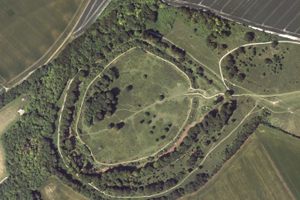About
The Danebury Meteorite is recognized as the earliest securely dated meteorite ever discovered in Britain. The ancient extraterrestrial, now on display at Andover’s Museum of the Iron Age, arrived on Earth between 2470 and 2230 years ago when it landed at Danebury Hillfort during the Iron Age.
It is uncertain whether its descent to Earth was seen by any prehistoric witnesses, regardless, it landed in a disused grain pit at the hillfort—a fortunate fall that would prove crucial to its preservation. For over two millennia, the meteorite remained buried undisturbed beneath layers of chalky soil that shielded it from the corrosive forces of nature and less favorable soil. Had it landed elsewhere, the meteorite likely would have succumbed to the elements, erasing any trace of this celestial relic.
During the peak period of activity at Danebury Hillfort in the Iron Age, numerous pits were constructed for grain storage. Archaeological excavations conducted between 1969 and 1988 revealed around 2,500 such pits. Though the meteorite was discovered by archaeologists in 1974 as part of these excavations, it was initially misidentified as slag, a byproduct of metalworking. It wasn't until 1989 that the metallic composition of the Danebury Meteorite was analyzed and its true nature was revealed, making this prehistoric arrival Britain's earliest dated meteorite ever discovered.
Related Tags
Know Before You Go
The Danebury Meteorite is on permanent display at the Andover Museum and Museum of the Iron Age.
Admission to the museums is "pay once, visit all year," allowing unlimited revisits within a year of initial purchase.
Community Contributors
Added By
Published
November 27, 2024




























